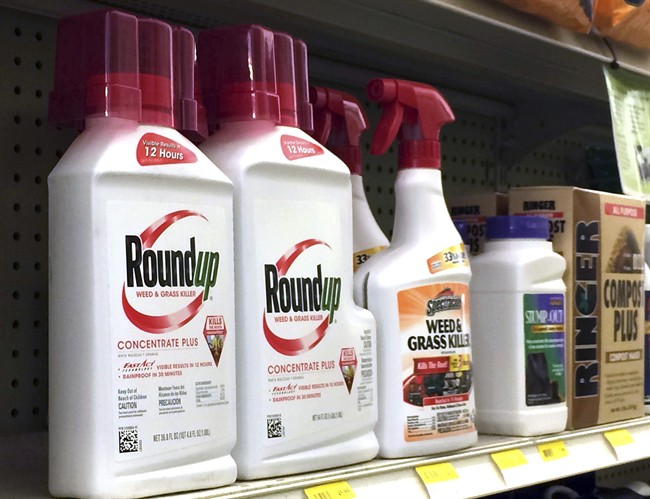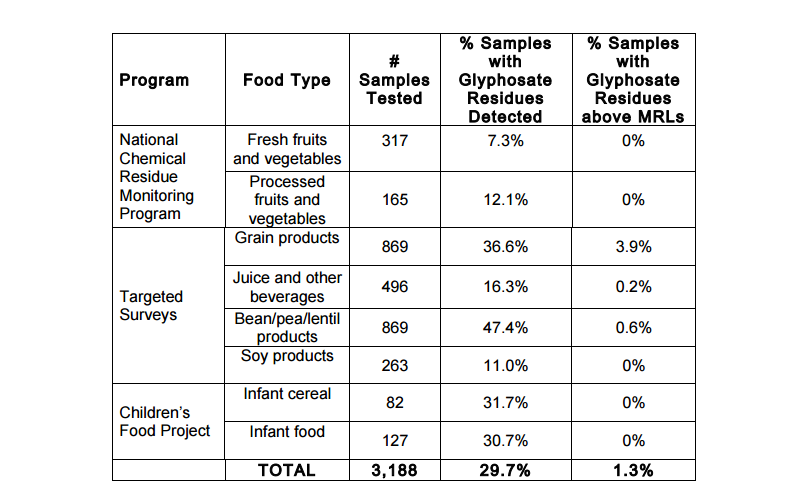The Canadian Food Inspection Agency says it has found trace amounts of a widely-used and controversial herbicide in roughly 30 per cent of food products it tested, and residue levels above the recommended limits in nearly four per cent of grain products.

Canada’s food safety watchdog released a report this week outlining the results of its glyphosate testing program which looked at more than 3,100 samples of domestic and imported food products in 2015 and 2016.
READ MORE: The Dirty Dozen and Clean 15: 2017’s list of fruits, vegetables with the most pesticides
Testing used 482 samples of fresh and processed fruits and vegetables, 2497 samples of grains (barley, buckwheat, and quinoa), beverages, bean, pea, lentil, chickpea and soy products and 209 retail samples of infant foods.
Here’s what the CFIA found when it tested food products for glyphosate residue and measured it against the Maximum Residue Limits (MRLs) set by Health Canada.
- In 869 samples of grain products, 36.6 per cent contained glyphosate and 3.9 per cent of samples showed levels higher than the MRL.
- In 869 samples of bean, pea, lentil, chickpea and soy products, 47.4 per cent of products contained glyphosate, with 0.6 per cent of samples showing levels higher than the MRL.
- In 127 samples of infant food, nearly 31 per cent contained traces of glyphosate, while 82 samples of infant cereal showed that roughly 32 per cent contained the herbicide. None of the samples tested contained residues above the MRL.
“The overall compliance rate for these surveys, based on Canadian Maximum Residue Limits (MRL), was 98.7 per cent,” the report said. “No samples of fruits and vegetables, soy products, or infant foods were found to contain residues exceeding Canadian limits. Most samples found with levels of residues exceeding Canadian limits were predominantly associated with grain products.”
Dr. Aline Dimitri, CFIA executive director of food safety science, says the report is “good news” for Canadians.
READ MORE: How the pesticide believed to be killing the bees could be affecting humans
Dimitri said brand names of the food items tested were not identified as they did not “pose a health and safety risk,” and were not relevant to the report.
“What we usually do is that if something does pose a risk, we trigger other tools that we have under our purview, particularly a recall and in that case the names of the brands that may be affected becomes part of the public domain,” she said.
READ MORE: Canada’s pea and lentil pesticide problem with India
Joe Schwarcz, director of the McGill Office for Science and Society, said the report is nothing new to experts who have studied the issue.
A link to cancer?
Glyphosate — the active ingredient in Roundup — is considered the most widely-used weed killer in the world, and controversy has grown globally about possible links to cancer.
A 2014 report from Health Canada’s Pest Management Regulatory Agency, obtained by Global News, showed that more than 25 million kilograms of glyphosate was sold across the country in 2014.
Used on everything from food crops to household lawns and gardens, Health Canada lists it as a safe product.
“The health effects noted in animals occur at doses more than 100 times higher (and often much higher) than levels to which humans are normally exposed when glyphosate products are used, according to label directions,” says the health agency.
READ MORE: Glyphosate petition tabled at NB legislature with nearly 30,000 signatures
However, the chemical has a complicated and politically fraught past with some environmental groups and studies suggesting it is carcinogenic.
A 2015 report by the World Health Organization’s International Agency for Research on Cancer originally labelled glyphosate as “probably carcinogenic to humans,” before reversing its position a year later.
The American Cancer Society also lists it as a “probable carcinogen.”
Schwarcz says it’s important to note the IARC reports measured “hazard” and not “risk” which are two very different things.
The U.S. Environmental Protection Agency and the European Food Safety Authority have both said it’s not carcinogenic, although questions have been raised about whether chemical giant Monsanto affected the EPA’s decision.
Last month, an article in the New York Times alleged that court documents containing Monsanto’s internal emails suggested the company had ghostwritten research attributed to other academics aimed at affecting the EPA’s review of Roundup and its main ingredient, glyphosate. In a statement to the Times, Monsanto denied the allegations.
Schwarcz said controversies around pesticide use is not just limited to glyphosate but dozens of other chemicals.
“People, including the media, often jump all over it and insinuate because it is there, it therefore presents a risk,” he said. “That is a very big jump.”






Comments